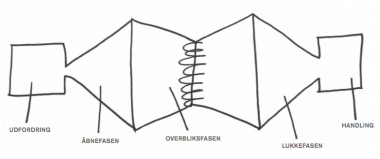The Open-Close model is a simple, innovation-related didactic model that deals with the process, from challenge to action, through 3 main phases: Open-, Overview-, and Close phases. The model can be used for a single lesson, for a longer course, in large interdisciplinary camps, but also to conduct meetings.
The advantage of an open-close model is that the open and close phases are equally weighted in terms of importance. The model requires that students not simply take the first and best solutions, but rather remain open to new ideas and other solutions for an extended period of time. There is not so much focus on the reformulation of the problem itself and carrying out of actual fieldwork. The Double Diamond model is also based on the equal weighting of divergent and convergent processes.

